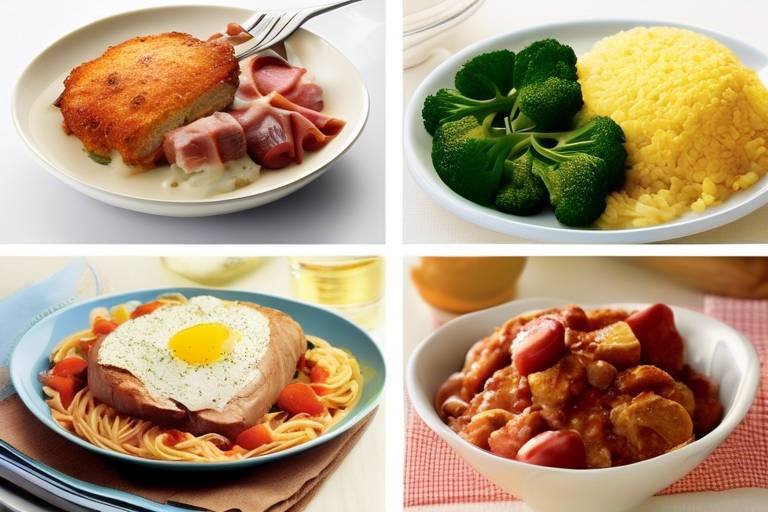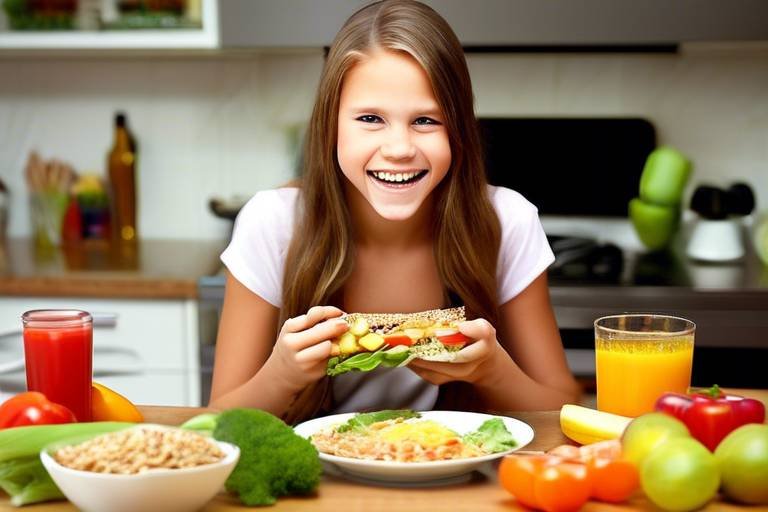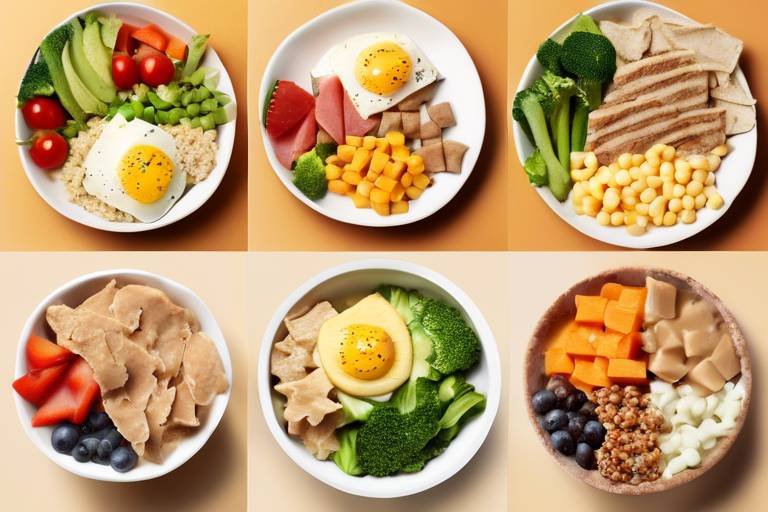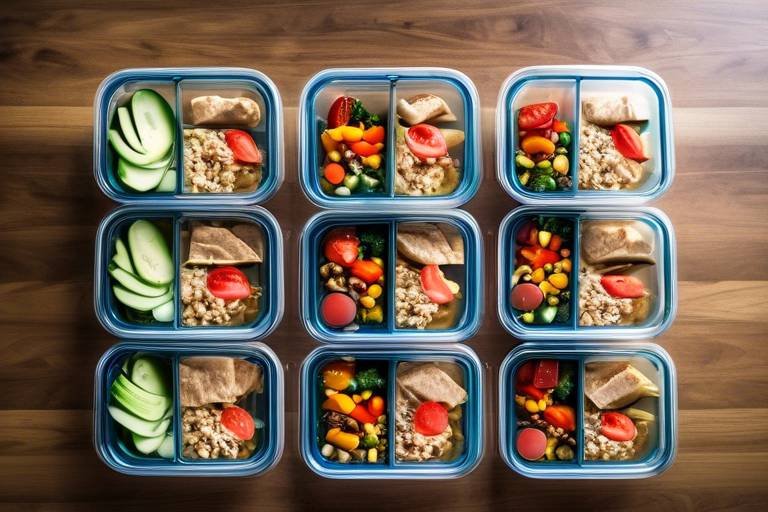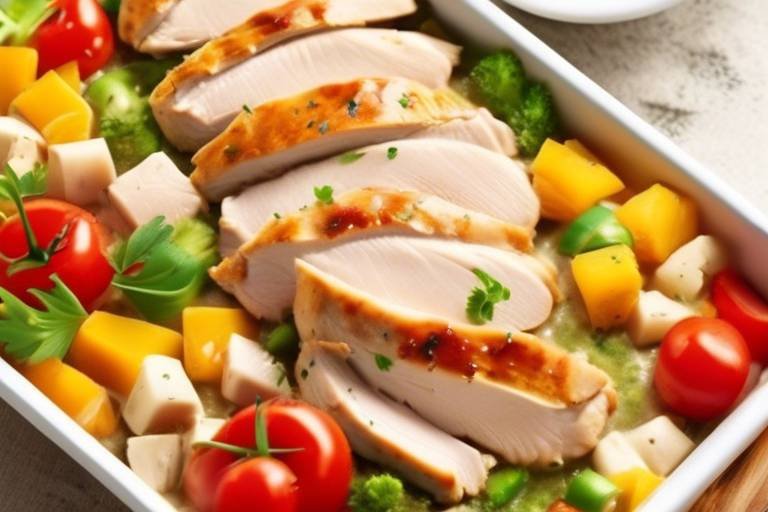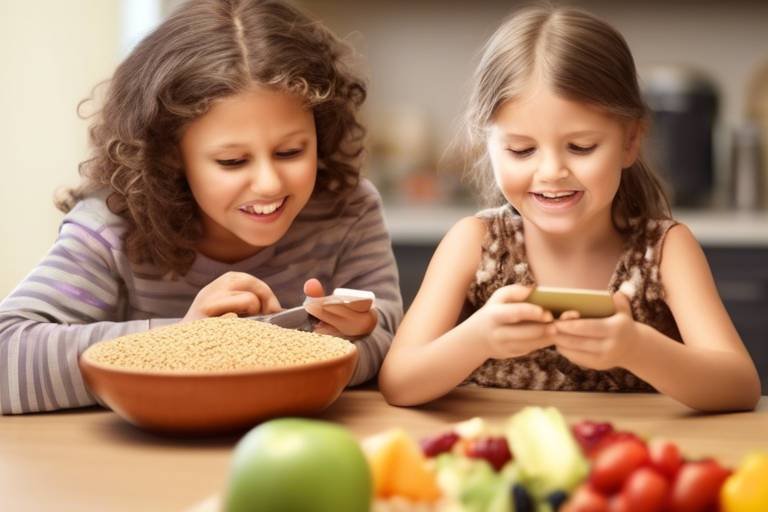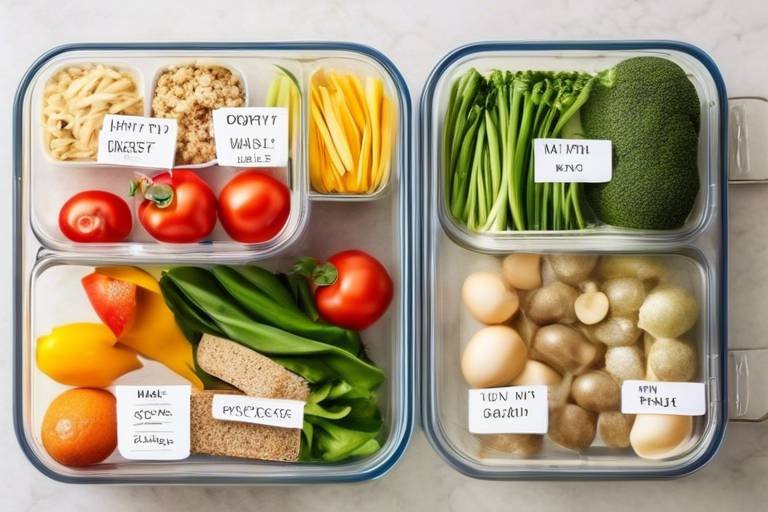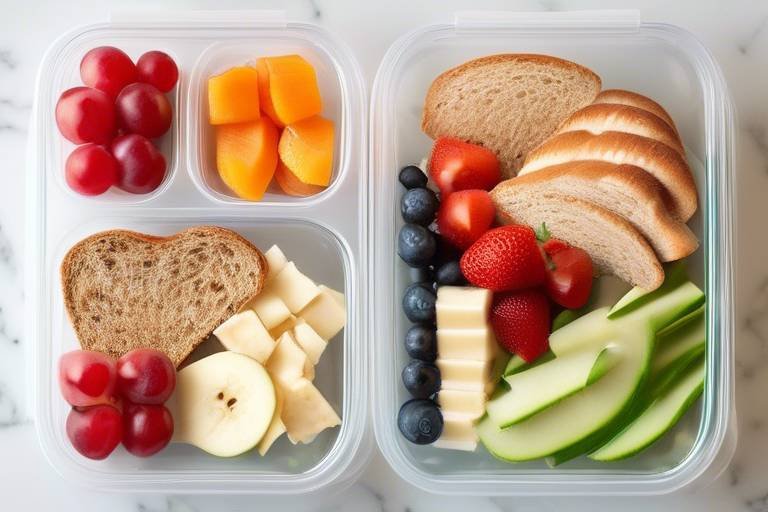Iron Rich Foods for Your Growing Kids
As parents, we all want the best for our children, and one of the most critical elements for their growth and development is iron. This essential mineral plays a vital role in producing hemoglobin, which carries oxygen in the blood. Without sufficient iron, children can face a range of health issues, including fatigue, weakened immunity, and even cognitive delays. So, how can we ensure that our little ones are getting enough iron in their diets? The answer lies in understanding the various iron-rich foods available and how to incorporate them creatively into meals.
Iron comes in two forms: heme and non-heme. Heme iron, found in animal products, is absorbed more efficiently by the body compared to non-heme iron, which is found in plant-based foods. This means that including a variety of both types in your child's diet can be incredibly beneficial. Think of iron as the fuel that keeps your child's engine running smoothly. Just like a car needs gasoline to function, kids need iron to support their energy levels and overall health.
In this article, we will explore the importance of iron in children's diets, highlight some of the best sources of iron, and provide tips on how to make these foods appealing to young taste buds. From delicious red meats to vibrant leafy greens, we will cover it all. Plus, we’ll delve into how pairing iron-rich foods with vitamin C can enhance absorption, ensuring your child gets the most out of their meals. So, buckle up as we embark on this nutritious journey together!
Iron is not just another mineral; it's a powerhouse that supports a child's growth and cognitive development. Did you know that iron deficiency can lead to developmental delays and learning difficulties? This is particularly concerning during the early years when their brains are rapidly developing. Imagine trying to build a house without a strong foundation; that's what a lack of iron does to a child's development. It’s crucial to include iron-rich foods in their diet to avoid these pitfalls.
Symptoms of iron deficiency can be subtle at first, often manifesting as fatigue, irritability, or difficulty concentrating. If left unaddressed, it can lead to more severe health issues. Therefore, understanding the importance of iron and recognizing the signs of deficiency is essential for parents. By making informed dietary choices, you can set your child up for a healthier, more vibrant life.
Now that we understand why iron is essential, let’s dive into the top iron-rich foods that can help keep your child’s levels optimal. It’s important to note that both animal and plant-based foods can be excellent sources of iron. Here’s a quick look at some of the best options:
| Food Source | Type of Iron | Serving Suggestions |
|---|---|---|
| Red Meat | Heme Iron | Grilled burgers, meatballs |
| Poultry | Heme Iron | Chicken stir-fry, baked chicken |
| Fish | Heme Iron | Baked salmon, fish tacos |
| Legumes | Non-Heme Iron | Chili, lentil soup |
| Nuts and Seeds | Non-Heme Iron | Trail mix, nut butter on toast |
| Leafy Greens | Non-Heme Iron | Salads, smoothies |
By incorporating a variety of these foods into your child's meals, you can ensure they receive the iron they need for healthy growth and development. Whether it's a hearty meat dish or a colorful salad packed with greens, there are countless ways to make iron-rich meals delicious and appealing.
Q1: How much iron do children need?
A1: The recommended daily intake of iron varies by age and gender. Generally, children aged 1-3 years need about 7 mg, while those aged 4-8 years need around 10 mg.
Q2: Can too much iron be harmful?
A2: Yes, excessive iron can lead to toxicity. It’s essential to balance iron intake and consult with a healthcare provider if you suspect your child may have an iron overload.
Q3: What are some signs of iron deficiency?
A3: Common signs include fatigue, pale skin, irritability, and poor concentration. If you notice these symptoms, consider consulting a healthcare professional.
Q4: How can I make iron-rich foods more appealing to my kids?
A4: Get creative! Use fun shapes, colorful presentations, and involve your kids in the cooking process to make meals more engaging.

Understanding Iron's Role in Child Development
Iron plays a vital role in the growth and development of children, acting as a key component in the production of hemoglobin, the protein in red blood cells responsible for transporting oxygen throughout the body. Without adequate iron, children may experience a range of health issues, including fatigue, weakened immunity, and hindered cognitive development. You might wonder, "How does this affect my child's ability to learn and play?" Well, studies have shown that iron deficiency can lead to developmental delays and impairments in attention span and learning capabilities.
Moreover, the need for iron increases during periods of rapid growth, such as infancy and adolescence. This is when kids are most vulnerable to iron deficiency, which can manifest in various ways. Symptoms may include pale skin, irritability, and decreased appetite. If you notice your child exhibiting any of these signs, it could be a signal that their iron levels are low. It’s crucial to recognize that the body's demand for iron is not just about physical health; it also influences mental and emotional well-being.
To better understand the significance of iron, let’s take a look at some key points:
- Supports Growth: Iron is essential for the production of new cells, making it crucial during growth spurts.
- Cognitive Development: Adequate iron levels are linked to improved memory and cognitive function.
- Immune Function: Iron plays a role in maintaining a healthy immune system, helping children fend off illnesses.
It's alarming to note that iron deficiency is one of the most common nutritional deficiencies worldwide, particularly among children. In fact, the World Health Organization estimates that around 40% of children globally are affected by this condition. This underscores the importance of incorporating iron-rich foods into your child's diet from an early age. By doing so, you can help ensure they have the necessary nutrients to thrive physically and mentally.
So, how can you make sure your little ones are getting enough iron? The answer lies in a balanced diet filled with a variety of iron-rich foods. But remember, not all iron sources are created equal! Heme iron, found in animal products, is absorbed more efficiently by the body compared to non-heme iron, which is found in plant-based foods. Therefore, understanding the differences can help you make informed choices when planning meals for your kids.

Top Iron-Rich Foods for Kids
When it comes to ensuring that your growing kids get the right nutrients, iron is a superstar mineral that you simply cannot overlook. Iron plays a pivotal role in their development, helping with everything from energy levels to cognitive function. But what are the best sources of iron that you can easily incorporate into your child's diet? Let's dive into some of the top iron-rich foods that can help keep your little ones healthy and thriving.
First up, we have animal-based sources, which are fantastic for providing heme iron. This type of iron is absorbed more efficiently by the body compared to non-heme iron found in plant foods. If your child enjoys meat, you're in luck! Red meat, poultry, and fish are not just tasty; they pack a powerful iron punch. A simple serving of beef or chicken can significantly boost their iron intake. But how can you make these foods appealing? Consider preparing a juicy beef stir-fry or crispy chicken tenders that are both delicious and nutritious.
Now, let’s break it down further. Red meat is often hailed as one of the richest sources of heme iron. Just a small serving can meet a significant portion of a child's daily iron needs. You might be wondering how to serve it in a way that kids will love. Think about creating flavorful meatballs, or even tacos, where the meat can shine through with spices and toppings that kids enjoy. Don't forget to pair it with some colorful veggies to make the plate visually appealing!
Next on the list are poultry and fish. Chicken and turkey are not only versatile but also packed with iron. Consider grilling chicken skewers or baking fish sticks that are crispy on the outside and tender on the inside. These meals can be fun to eat and easy for kids to help prepare, making them more likely to enjoy the process and the food. Plus, fish like salmon is rich in omega-3 fatty acids, adding even more health benefits to the mix.
For families that lean towards vegetarian or vegan diets, plant-based iron sources are essential. Foods like lentils, beans, and chickpeas are fantastic options that are not only rich in iron but also provide fiber and protein. You can whip up a hearty lentil soup or make delicious bean burgers that are sure to please even the pickiest eaters. Adding some nuts and seeds to salads or snacks can also give a nice iron boost. Just keep in mind that the iron from plant sources is non-heme iron, so it’s important to pair these foods with vitamin C-rich options to enhance absorption.
Speaking of enhancing absorption, let’s not forget about the power of vitamin C. Foods like oranges, strawberries, and bell peppers can significantly improve how well your child’s body absorbs iron. So, when you're serving up a delicious iron-rich meal, think about adding a side of fresh fruit or a colorful salad. This combination not only makes for a balanced meal but also keeps the taste buds excited!
In conclusion, there are plenty of delicious and nutritious iron-rich foods available for your kids. Whether you’re opting for animal-based options like red meat, poultry, and fish, or embracing plant-based choices such as lentils and nuts, the key is to make these foods enjoyable and accessible. With a little creativity in the kitchen, you can ensure that your children not only get the iron they need but also develop a lifelong love for healthy eating.
1. Why is iron important for children?
Iron is essential for children as it supports their growth, energy production, and cognitive development. A deficiency can lead to fatigue, weakness, and developmental delays.
2. How can I tell if my child is iron deficient?
Symptoms of iron deficiency may include fatigue, pale skin, irritability, and frequent infections. If you suspect a deficiency, consult your pediatrician for proper testing and advice.
3. Can too much iron be harmful?
Yes, while iron is crucial, excessive intake can lead to toxicity. It's important to follow recommended dietary allowances and consult a healthcare professional if considering supplements.
4. What are some quick iron-rich snacks for kids?
Some quick snacks include hummus with veggies, trail mix with nuts and dried fruits, or whole-grain crackers with cheese. These options are not only tasty but also help boost iron intake!

Animal-Based Iron Sources
When it comes to boosting your child's iron intake, animal-based sources are often the most effective. These foods provide heme iron, which is more readily absorbed by the body compared to non-heme iron found in plant sources. This is particularly important for growing kids who need sufficient iron for their development. Think of heme iron as the VIP pass to better nutrition—it's the kind that your body can use easily and efficiently!
Among the best animal-based sources of iron, red meat stands out as a powerhouse. Not only is it rich in iron, but it also contains essential nutrients like protein and zinc, which are crucial for your child's growth. When serving red meat, try to choose lean cuts to keep it healthy. You can prepare delicious meals like beef stir-fry or meatballs that appeal to even the pickiest eaters. The key is to make it fun and flavorful! Kids love to eat with their hands, so consider serving meatballs with toothpicks and a side of dipping sauce.
Next up, we have poultry and fish. Chicken and turkey are excellent sources of iron and can be easily incorporated into various dishes. For instance, you could whip up a chicken taco night where kids can build their own tacos with plenty of toppings. This not only makes the meal interactive but also allows you to sneak in some iron-rich ingredients like beans and cheese. Fish, particularly varieties like salmon and tuna, are also great options. They are not only rich in iron but also packed with omega-3 fatty acids, which are fantastic for brain development. You might even consider making fish sticks at home—baked instead of fried, of course!
To further enhance your child's iron intake, consider creating a balanced plate that includes a variety of these animal-based sources. Here’s a quick breakdown:
| Food Source | Iron Content (mg per 100g) | Serving Suggestions |
|---|---|---|
| Red Meat | 2.7 | Beef stir-fry, meatballs |
| Poultry | 1.3 | Chicken tacos, grilled chicken |
| Fish | 1.0 | Baked salmon, fish sticks |
Incorporating these animal-based iron sources into your child's diet doesn’t have to be a chore. By experimenting with different cooking methods and flavors, you can create meals that are not only nutritious but also enjoyable. Remember, the goal is to make iron-rich foods appealing so that your little ones look forward to eating them!

Red Meat
When it comes to boosting your child's iron intake, stands out as a powerhouse option. Rich in heme iron, which is the type of iron that the body absorbs most efficiently, red meat can play a crucial role in your child's diet. Think of it as a superhero for their growth and development, providing not just iron but also essential nutrients like protein, zinc, and B vitamins that are vital for energy and overall health.
But how can you make red meat appealing to your little ones? The key is in the preparation and presentation. Children are often more likely to enjoy meals that are colorful and fun. For instance, consider making meatballs or tacos with ground beef, which can be easily customized with their favorite toppings, such as cheese, lettuce, and salsa. You could also try marinating cuts of steak and grilling them to perfection, serving it with a side of their favorite veggies. This not only enhances the flavor but also makes the meal visually appealing.
Here’s a quick look at some popular red meat options and their iron content:
| Type of Red Meat | Iron Content (mg per 100g) |
|---|---|
| Ground Beef | 2.6 |
| Beef Steak | 2.7 |
| Lamb Chops | 1.8 |
It's important to remember that moderation is key. While red meat is beneficial, it’s best to balance it with other food groups to ensure a well-rounded diet. Pairing red meat with vegetables and whole grains can enhance the meal's nutritional value. For example, serving a beef stir-fry with colorful bell peppers and brown rice not only adds fiber but also makes the dish more enticing for your child.
In conclusion, incorporating red meat into your child's diet can be a delicious and effective way to ensure they are getting enough iron. By being creative in the kitchen and presenting these meals in a fun way, you can help your kids develop healthy eating habits that last a lifetime.
- How often should my child eat red meat? It’s generally recommended to include red meat in your child's diet a few times a week, but always consult with a pediatrician for personalized advice.
- What are some alternatives to red meat for iron intake? If red meat isn't an option, consider poultry, fish, legumes, and fortified cereals as excellent sources of iron.
- Can I serve red meat to toddlers? Yes, but ensure it is cooked well and cut into small, manageable pieces to prevent choking hazards.

Poultry and Fish
Poultry and fish are not just delicious; they're also fantastic sources of iron that can help fuel your child's growth and development. When we talk about poultry, we're mainly referring to chicken and turkey, both of which are rich in heme iron. Heme iron is the type of iron that your body absorbs most efficiently, making these proteins a fantastic addition to your child's diet. Imagine your kiddo soaring through their day like a superhero, powered by the nutrients they get from a well-balanced meal that includes poultry!
But let's not forget about fish! Varieties like salmon and tuna not only provide iron but also come packed with omega-3 fatty acids, which are essential for brain health. Incorporating fish into your meals can be as simple as adding it to pasta or making fish tacos. It's like giving your child a double dose of goodness in one meal—iron for their body and healthy fats for their brain!
Here are some tips to make poultry and fish more appealing to your little ones:
- Make it Fun: Use cookie cutters to create fun shapes from cooked chicken or fish. Kids love eating food that looks playful!
- Flavor it Up: Marinate chicken in their favorite sauces or seasonings. A little garlic or lemon can make a world of difference.
- Try Different Cooking Methods: Baking, grilling, or even stir-frying can change the texture and flavor, making it more enjoyable for kids.
For parents who might be concerned about how to introduce these foods, remember that the key is to start slow. You might begin with a simple baked chicken breast served alongside colorful veggies, or perhaps a fish fillet lightly seasoned and served with a side of rice. As your child becomes accustomed to these flavors, you can gradually introduce more complex dishes. It's all about creating a positive experience around mealtime!
Lastly, consider the nutritional benefits: a 3-ounce serving of cooked chicken can provide around 0.9 mg of iron, while the same serving of salmon offers about 0.5 mg. These amounts may seem small, but when combined with a variety of other iron-rich foods, they can significantly contribute to your child’s daily iron intake. So, why not make poultry and fish a regular part of your family meals? It's a simple yet effective way to ensure your kids are getting the nutrients they need to thrive!

Plant-Based Iron Sources
When it comes to ensuring that your little ones get enough iron, plant-based sources can be a fantastic option, especially for vegetarian and vegan families. While it’s true that heme iron, found in animal products, is more easily absorbed by the body, there are plenty of plant-based foods that can help meet your child's iron needs. These foods are not only nutritious but can also be delicious when prepared creatively. Let’s dive into some amazing plant-based sources of iron that you can incorporate into your child's diet.
One of the best plant-based sources of iron is legumes. Foods like lentils, chickpeas, and beans are not only rich in iron, but they also provide protein and fiber, making them a great addition to any meal. For instance, a hearty lentil soup can be both comforting and packed with nutrients. You can also make a fun and tasty chickpea salad that your kids will love. Just toss in some colorful veggies and a squeeze of lemon for a refreshing twist!
Nuts and seeds are another excellent source of iron. Almonds, cashews, and pumpkin seeds can easily be sprinkled on salads, blended into smoothies, or enjoyed as a snack. Consider creating a homemade trail mix with a variety of nuts and dried fruits. This not only provides a healthy snack option but also makes it easy for kids to munch on something nutritious while on the go.
Don’t forget about leafy greens like spinach and kale. These greens are not only iron-rich but also packed with vitamins and minerals. You can sneak them into smoothies, mix them into pasta dishes, or create a colorful salad that your kids can help assemble. When cooked, spinach can be deliciously combined with garlic and olive oil, making it a side dish that even picky eaters might enjoy.
To maximize the benefits of these iron-rich foods, it’s essential to pair them with sources of vitamin C. This vitamin enhances iron absorption, so consider adding fruits like oranges, strawberries, or kiwi to meals that feature these plant-based iron sources. For example, you can make a vibrant quinoa salad with black beans, diced bell peppers, and a squeeze of lime juice, providing both iron and vitamin C in one delightful dish.
In summary, incorporating plant-based iron sources into your child's diet doesn't have to be a chore. With a little creativity and the right combinations, you can create meals that are not only nutritious but also appealing to young taste buds. Remember, the goal is to make these foods fun and enjoyable, so get your kids involved in the cooking process and watch them take an interest in their nutrition!

Combining Iron with Vitamin C
When it comes to ensuring that our little ones get enough iron, there’s a secret ingredient that can make a world of difference: Vitamin C. This dynamic duo is like peanut butter and jelly; they just work better together! Vitamin C enhances the body's ability to absorb iron, especially the non-heme iron found in plant-based foods. So, if you want to maximize the nutritional benefits of iron-rich meals, it’s crucial to pair them with foods high in Vitamin C.
Imagine serving your child a delicious plate of spinach and chickpeas for dinner. While both are excellent sources of iron, adding a side of orange slices or a strawberry salad can significantly boost iron absorption. This means that your child is not only enjoying a colorful and tasty meal but also getting the most out of the nutrients!
To help you navigate this flavorful journey, here are some fantastic food pairings that can elevate iron absorption:
| Iron-Rich Food | Vitamin C Source |
|---|---|
| Spinach | Strawberries |
| Chickpeas | Bell Peppers |
| Red Meat | Broccoli |
| Lentils | Tomatoes |
These combinations not only provide essential nutrients but also make meals more appealing to kids. Think of it like a colorful art project on their plates! You can create fun shapes with fruits and veggies, or even involve your kids in the kitchen to make mealtime an exciting adventure. After all, when children are part of the cooking process, they’re more likely to eat what they’ve helped prepare.
So, next time you’re planning your grocery list or prepping meals, remember to think about how you can pair iron-rich foods with Vitamin C. It’s a simple yet effective way to ensure your kids are getting the nutrition they need for their growth and development. And who knows? They might just surprise you by asking for seconds!
Q: Why is iron important for children?
A: Iron is essential for healthy growth, cognitive development, and the production of hemoglobin, which carries oxygen in the blood. A deficiency can lead to fatigue, weakness, and developmental delays.
Q: How can I tell if my child is getting enough iron?
A: Symptoms of iron deficiency can include fatigue, pale skin, and irritability. If you suspect a deficiency, consult your pediatrician for advice and potential testing.
Q: Can too much iron be harmful?
A: Yes, while iron is essential, excessive amounts can be harmful and lead to conditions like iron overload. It’s important to maintain a balanced diet and consult a healthcare provider if you have concerns.
Q: What are some easy ways to incorporate Vitamin C into meals?
A: You can add fruits like oranges, strawberries, and kiwi to breakfast cereals, serve bell peppers in salads, or include tomatoes in sauces and soups to boost Vitamin C intake.

Fruits and Vegetables to Pair
When it comes to boosting your child's iron absorption, pairing iron-rich foods with vitamin C sources is a game changer. Think of it like a dynamic duo in a superhero movie; together, they pack a powerful punch! Vitamin C enhances the body's ability to absorb non-heme iron, which is primarily found in plant-based foods. So, if you're serving up lentils or spinach, consider adding a side of citrus or bell peppers to maximize the nutritional benefits.
Some of the best fruits that are high in vitamin C include oranges, kiwis, and strawberries. These fruits are not only delicious but also easy to incorporate into your child's diet. For instance, you can whip up a refreshing fruit salad that includes these vitamin-packed options, or simply serve orange slices alongside a hearty bean dish. Additionally, bell peppers, broccoli, and tomatoes are excellent vegetable choices that can be added to meals to enhance both flavor and nutrition.
To give you a clearer picture, here’s a simple table that showcases some great combinations of iron-rich foods and their vitamin C counterparts:
| Iron-Rich Food | Vitamin C Pairing |
|---|---|
| Lentils | Bell Peppers |
| Spinach | Strawberries |
| Chickpeas | Broccoli |
| Tofu | Oranges |
Incorporating these combinations into your meals can be both fun and delicious! For instance, you could prepare a vibrant stir-fry with chickpeas and broccoli, drizzled with a zesty orange dressing. Or, how about a spinach salad topped with sliced strawberries and toasted nuts? The possibilities are endless, and your kids will love the flavors!
Remember, the key is to make it enjoyable. Engage your little ones in the kitchen—let them help you pick out fruits and vegetables at the store or assist in preparing meals at home. Not only does this make them more likely to try new foods, but it also teaches them the importance of balanced nutrition. After all, when kids are involved, they are more likely to embrace healthy eating habits that will last a lifetime!
Q: Why is iron important for children?
A: Iron is crucial for the development of healthy blood cells, which transport oxygen throughout the body. It also plays a vital role in cognitive development, energy levels, and overall growth.
Q: How can I tell if my child is iron deficient?
A: Symptoms of iron deficiency may include fatigue, pale skin, irritability, and poor concentration. If you suspect your child may be iron deficient, consult a healthcare professional for proper testing and guidance.
Q: Can iron from plant sources be as effective as iron from meat?
A: While plant-based iron (non-heme iron) is less easily absorbed than heme iron from animal sources, pairing it with vitamin C can significantly enhance absorption, making it effective for meeting your child's needs.
Q: What are some easy ways to include more iron-rich foods in my child's diet?
A: Try incorporating iron-rich foods into smoothies, soups, and salads. You can also experiment with fun recipes like iron-fortified pancakes or energy bites made with nuts and seeds.

Creative Ways to Serve Iron-Rich Foods
Getting kids to eat their iron-rich foods can sometimes feel like trying to convince a cat to take a bath—challenging and often met with resistance! But don't worry, there are plenty of creative ways to make these nutritious foods not only appealing but also fun for your little ones. The trick lies in presentation and imagination. Think of meals as a canvas, where you can paint vibrant colors and shapes that attract your child's attention.
One effective method is to turn traditional dishes into fun shapes. For example, you can create iron-rich pancakes using whole wheat flour and spinach, then use cookie cutters to shape them into stars or hearts. Kids love anything that looks playful, and the vibrant green from spinach can make for a visually appealing meal. Serve these pancakes with a side of orange slices to boost their vitamin C intake, enhancing iron absorption.
Another fantastic idea is to make iron-rich smoothies. Blend together spinach, bananas, and a scoop of almond butter for a delicious drink that packs a punch of nutrients. Kids often don’t realize they’re consuming greens when they’re blended with sweet fruits, and you can even let them help with the blending process. This not only makes them feel involved but also turns meal prep into a fun activity!
If your kids enjoy sandwiches, consider creating iron-packed wraps using whole grain tortillas filled with hummus, shredded chicken, and colorful veggies. You can even roll the tortillas tightly and slice them into pinwheels. This fun presentation can make healthy eating feel like a party on a plate!
For a more interactive dining experience, try setting up a build-your-own bowl night. Lay out a variety of iron-rich ingredients like quinoa, black beans, grilled chicken, and diced bell peppers, and let the kids create their own meals. This not only encourages them to try new foods but also allows them to take ownership of their meal, making them more likely to eat it.
Don't forget about the power of dipping sauces. Kids love to dip, so serve iron-rich foods like roasted chickpeas or baked sweet potato fries with a fun dip like tzatziki or guacamole. This makes the eating experience more playful and can help them enjoy foods they might otherwise shy away from.
Lastly, consider using themed dinners to make iron-rich meals exciting. For instance, you could have a "Taco Tuesday" featuring ground turkey or lentils, topped with plenty of colorful veggies and served with a side of fresh salsa. Themed meals can spark interest and anticipation, making your children more eager to try what's on their plate.
In summary, serving iron-rich foods to kids doesn't have to be a battle. With a bit of creativity, you can transform nutritious ingredients into meals that are not only healthy but also fun and engaging. Remember, the key is to make it enjoyable, so your children develop a love for these essential foods that will benefit them for years to come!
Q: How can I ensure my child is getting enough iron?
A: Incorporate a variety of iron-rich foods into their diet, both from animal and plant sources. Regularly check in with a pediatrician to monitor iron levels through blood tests if necessary.
Q: Can I use supplements if my child is a picky eater?
A: While supplements can help, it's best to focus on whole food sources first. If you think your child may need additional iron, consult your healthcare provider before starting any supplements.
Q: What are some signs of iron deficiency in children?
A: Symptoms can include fatigue, irritability, pale skin, and poor concentration. If you notice these signs, consult a healthcare professional for advice.

Fun and Engaging Meal Ideas
Getting kids excited about eating iron-rich foods can feel like a daunting task, but with a sprinkle of creativity and a dash of fun, you can turn mealtime into an adventure! Think of it as a culinary quest where every meal is a new discovery. For instance, why not transform a simple plate of red meat into a superhero burger? By using whole grain buns, lean ground beef, and colorful toppings like spinach and tomatoes, you can create a meal that not only packs a punch in terms of iron but also looks appealing and fun. Kids love the idea of superheroes, and when they see their food presented in a way that sparks their imagination, they’re more likely to dig in!
Another exciting idea is to make iron-rich wraps. Start with a whole grain tortilla and fill it with shredded chicken or turkey, black beans, and a mix of vibrant veggies like bell peppers and carrots. To add a twist, let the kids help assemble their own wraps. This not only makes them feel involved but also encourages them to try new ingredients. You can even create a wrap bar at home where kids can choose their fillings, making it a fun and interactive meal.
And let’s not forget about breakfast! You can whip up some iron-fortified smoothies by blending spinach or kale with fruits like bananas and strawberries. Add a scoop of nut butter for an extra boost of iron and protein. Not only is this a quick meal option, but it also turns breakfast into a colorful, delicious treat that kids will love. Just imagine them slurping down a green smoothie and feeling like they’re drinking a magic potion!
For a delightful twist on dinner, consider making iron-rich pizza. Use a whole grain crust and top it with a rich tomato sauce, lean ground beef, and plenty of veggies like mushrooms and spinach. Let the kids help sprinkle cheese on top. The best part? You can sneak in some extra iron by using fortified cheese or adding a side salad with chickpeas. When they see their pizza bubbling in the oven, they’ll be eager to dig in!
Lastly, don't underestimate the power of fun shapes and colors. Use cookie cutters to create fun shapes out of cooked meats, veggies, or even sandwiches. A star-shaped chicken nugget or a heart-shaped veggie patty can make the meal feel special and exciting. The more visually appealing the food, the more likely kids are to try it!
Incorporating iron-rich foods into your child's diet doesn’t have to be boring or bland. With a little creativity and the right presentation, you can make every meal a fun and engaging experience. Remember, the goal is to create a positive association with healthy foods, so keep it light-hearted and enjoyable!
Q: What are some signs of iron deficiency in children?
A: Common signs include fatigue, pale skin, irritability, and difficulty concentrating. If you notice these symptoms, it’s essential to consult a healthcare professional.
Q: How can I ensure my child gets enough iron on a vegetarian diet?
A: Focus on incorporating plant-based sources of iron such as lentils, beans, tofu, and fortified cereals. Pair these with vitamin C-rich foods to enhance absorption.
Q: Are there any side effects of consuming too much iron?
A: Yes, excessive iron can lead to health issues, including gastrointestinal problems. It's crucial to follow recommended dietary guidelines and consult a doctor if you have concerns.
Q: How can I make iron-rich foods more appealing to picky eaters?
A: Get creative with presentation, involve them in cooking, and try to incorporate their favorite flavors into iron-rich dishes. Fun shapes and colors can also make a big difference!
Frequently Asked Questions
- What are the signs of iron deficiency in children?
Iron deficiency in children can manifest in various ways. Common signs include fatigue, pale skin, irritability, and difficulty concentrating. If your child seems unusually tired or has a decreased appetite, it might be time to consult a healthcare professional for a blood test.
- How can I ensure my child gets enough iron?
To ensure your child gets enough iron, include a variety of iron-rich foods in their diet. This can include red meat, poultry, fish, beans, lentils, and fortified cereals. Pair these with vitamin C-rich foods like oranges or bell peppers to enhance absorption.
- Are plant-based sources of iron sufficient for my child's needs?
Absolutely! While plant-based sources provide non-heme iron, which is less easily absorbed than heme iron from animal products, they can still meet your child's needs when consumed in adequate amounts. Combining these foods with vitamin C can significantly improve absorption.
- Can cooking methods affect iron content in foods?
Yes, cooking methods can impact the iron content in foods. For instance, cooking spinach can reduce its oxalate content, making the iron more available for absorption. Similarly, soaking and sprouting beans and grains can enhance their iron bioavailability.
- What are some kid-friendly recipes that are high in iron?
Kid-friendly recipes high in iron include iron-fortified breakfast cereals, lentil soups, chicken stir-fry with colorful veggies, and homemade meatballs. You can also sneak spinach into smoothies or pasta sauces for added nutrition without compromising taste!
- Is it possible for a child to have too much iron?
Yes, while iron is essential, too much can be harmful. Iron overload can lead to serious health issues. It's crucial to stick to recommended dietary allowances and consult a healthcare professional before giving iron supplements to your child.


